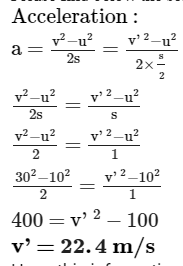Class 9 Exam > Class 9 Questions > A particle is moving rectilinearly with const...
Start Learning for Free
A particle is moving rectilinearly with constant acceleration is having initial velocity 10 m/s and aftersometime velocity becomes 30m/s find out its velocity at the mid point
?
?
Most Upvoted Answer
A particle is moving rectilinearly with constant acceleration is havin...

Community Answer
A particle is moving rectilinearly with constant acceleration is havin...
Understanding Constant Acceleration
When a particle moves with constant acceleration, its velocity changes uniformly over time. In this case, we have an initial velocity (u) of 10 m/s and a final velocity (v) of 30 m/s.
Finding the Midpoint Velocity
To find the velocity at the midpoint of the motion, we can use the concept of average velocity during constant acceleration. The average velocity (v_avg) can be calculated as follows:
Average Velocity Formula
- The formula for average velocity when acceleration is constant is:
- v_avg = (u + v) / 2
Calculating the Average Velocity
- Substituting the given values:
- u = 10 m/s
- v = 30 m/s
- Thus,
- v_avg = (10 m/s + 30 m/s) / 2
- v_avg = 40 m/s / 2
- v_avg = 20 m/s
Conclusion
The velocity at the midpoint of the particle's motion, when it transitions from an initial velocity of 10 m/s to a final velocity of 30 m/s, is 20 m/s. This average velocity reflects the uniform change in speed due to constant acceleration.
When a particle moves with constant acceleration, its velocity changes uniformly over time. In this case, we have an initial velocity (u) of 10 m/s and a final velocity (v) of 30 m/s.
Finding the Midpoint Velocity
To find the velocity at the midpoint of the motion, we can use the concept of average velocity during constant acceleration. The average velocity (v_avg) can be calculated as follows:
Average Velocity Formula
- The formula for average velocity when acceleration is constant is:
- v_avg = (u + v) / 2
Calculating the Average Velocity
- Substituting the given values:
- u = 10 m/s
- v = 30 m/s
- Thus,
- v_avg = (10 m/s + 30 m/s) / 2
- v_avg = 40 m/s / 2
- v_avg = 20 m/s
Conclusion
The velocity at the midpoint of the particle's motion, when it transitions from an initial velocity of 10 m/s to a final velocity of 30 m/s, is 20 m/s. This average velocity reflects the uniform change in speed due to constant acceleration.

|
Explore Courses for Class 9 exam
|

|
Similar Class 9 Doubts
Question Description
A particle is moving rectilinearly with constant acceleration is having initial velocity 10 m/s and aftersometime velocity becomes 30m/s find out its velocity at the mid point? for Class 9 2025 is part of Class 9 preparation. The Question and answers have been prepared according to the Class 9 exam syllabus. Information about A particle is moving rectilinearly with constant acceleration is having initial velocity 10 m/s and aftersometime velocity becomes 30m/s find out its velocity at the mid point? covers all topics & solutions for Class 9 2025 Exam. Find important definitions, questions, meanings, examples, exercises and tests below for A particle is moving rectilinearly with constant acceleration is having initial velocity 10 m/s and aftersometime velocity becomes 30m/s find out its velocity at the mid point?.
A particle is moving rectilinearly with constant acceleration is having initial velocity 10 m/s and aftersometime velocity becomes 30m/s find out its velocity at the mid point? for Class 9 2025 is part of Class 9 preparation. The Question and answers have been prepared according to the Class 9 exam syllabus. Information about A particle is moving rectilinearly with constant acceleration is having initial velocity 10 m/s and aftersometime velocity becomes 30m/s find out its velocity at the mid point? covers all topics & solutions for Class 9 2025 Exam. Find important definitions, questions, meanings, examples, exercises and tests below for A particle is moving rectilinearly with constant acceleration is having initial velocity 10 m/s and aftersometime velocity becomes 30m/s find out its velocity at the mid point?.
Solutions for A particle is moving rectilinearly with constant acceleration is having initial velocity 10 m/s and aftersometime velocity becomes 30m/s find out its velocity at the mid point? in English & in Hindi are available as part of our courses for Class 9.
Download more important topics, notes, lectures and mock test series for Class 9 Exam by signing up for free.
Here you can find the meaning of A particle is moving rectilinearly with constant acceleration is having initial velocity 10 m/s and aftersometime velocity becomes 30m/s find out its velocity at the mid point? defined & explained in the simplest way possible. Besides giving the explanation of
A particle is moving rectilinearly with constant acceleration is having initial velocity 10 m/s and aftersometime velocity becomes 30m/s find out its velocity at the mid point?, a detailed solution for A particle is moving rectilinearly with constant acceleration is having initial velocity 10 m/s and aftersometime velocity becomes 30m/s find out its velocity at the mid point? has been provided alongside types of A particle is moving rectilinearly with constant acceleration is having initial velocity 10 m/s and aftersometime velocity becomes 30m/s find out its velocity at the mid point? theory, EduRev gives you an
ample number of questions to practice A particle is moving rectilinearly with constant acceleration is having initial velocity 10 m/s and aftersometime velocity becomes 30m/s find out its velocity at the mid point? tests, examples and also practice Class 9 tests.

|
Explore Courses for Class 9 exam
|

|
Signup to solve all Doubts
Signup to see your scores go up within 7 days! Learn & Practice with 1000+ FREE Notes, Videos & Tests.


























